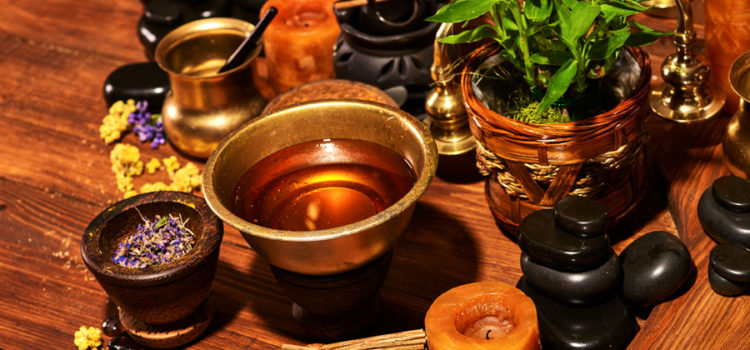
Nurture yourself with a healing massage every day
Abhyanga is the Ayurvedic art of massage with healing oils. There are a host of benefits from regular abhyanga therapy, whether performed by an Ayurvedic practitioner or at home for yourself.
Benefits of Abhyanga
- Improved circulation, strength, vision and stamina
- Increased moisture for softer skin
- Improved texture, tone and overall skin appearance
- Strengthened bodily tissues, lubrication of internal organs, bones and joints
- Better sleep and overall health
Self-massage does not have to be a time consuming process. A regular practice of self-abhyanga, or oil massage, in conjunction with at least one monthly synchronized abhyanga therapy by qualified Panchakarma Technicians is recommended. At home, you can perform self-abhyanga each morning after your skin is prepped by your dry brush and ready to receive the oil’s hydrating nourishment.
Selecting your oil
Oils can be selected based on individual constitution, imbalances and influences of the season. Traditionally, sesame and coconut oil have been used in India for thousands of years for daily self-abhyanga.
Coconut oil is fundamentally cooling to the system and best for late spring, summer and early fall days, as well as individuals with excess heat in the system.
Sesame oil is fundamentally warming to the system and is best for late fall, winter and early spring days, as well as individuals with excess cold in the system.
Traditional Ayurvedic oils incorporate healing herbs with the oil for increased benefits. The blend of herbs in the oil may benefit a particular Ayurvedic constitution or address specific imbalances. You can learn more about the traditional oils offered by Kerala Ayurveda here.
Steps to perform the self-abhyanga
- Brush your skin with a dry brush to remove dead skin, dirt and debris from its surface as well as prepare the skin’s pores for receiving the oil.
- Warm your oil – you can do this while dry brushing if warming your oil in a pot, or rub the oil between your palms if you are short on time.
- Gently but firmly, massage your body all over: begin with the neck, working your way down to your feet. Use long strokes for limbs and short strokes for joints. Don’t forget fingers and toes, and pay extra attention to the soles of your feet, as they contain all the nerve endings and important marma points, or conjunctions of prana, life force energy.
- Let the oil sit for 5-10 minutes. Don’t skip this step, as abhyanga’s deeper benefits depend on the body’s absorption of the oil and herbs. It takes a few minutes for the oil to penetrate to the deepest layers of the skin, and another several minutes for it to penetrate the tissues of the internal body. This is an excellent time to prepare some tea or practice some deep breathing.
- Rinse excess oil with a cold shower on warm days, or a cool shower (but not hot) on cold days. Don’t skip this step either, as excess oil will clog the pores.
Frequency
You can practice self-abhyanga daily, though you’ll receive wonderful benefits even from practicing it just a 2-3 times a week.
About the author
-

Jamila is a certified Ayurvedic Wellness Counselor (AWC), Yoga Teacher (CYT) and Level I Reiki Practitioner. She earned her Bachelor of Arts (BA) in Literature & Journalism from New York University and channels her combined marketing skills, artistry and ancient wisdom to spread content seeds that elevate the attention economy, promote healing and radical planetary growth. In her dedication to...
View all posts

